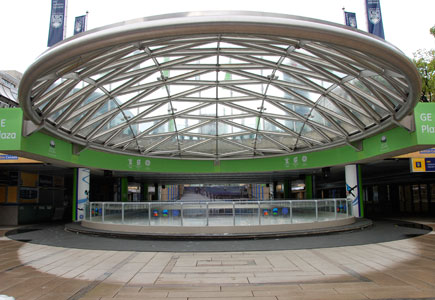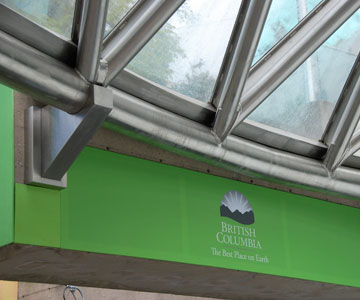Finishes
Stainless Steel
Stainless steel has the advantage of having its corrosion protection quite integral to the structural member. It is an iron based metal that has at least 10.5% chromium as well as quantities of nickel, molybdenum and manganese that assist in resisting oxidation. The chromium combines with oxygen to create a barrier to the rust that would normally form due to the iron content. As a result it has a remarkable finish and requires far less ongoing maintenance than does regular steel protected through methods of galvanizing, metallizing or with painted or intumescent coatings.
 |
 |
The domes over the recreation area of Robson Square in Vancouver, BC were completely redone in time for the 2010 Olympic Games. The previous domes were replaced with stainless steel frames, for long lasting durablity and great aesthetics. |
The details on teh dome were carefully worked out to ensure maximum fabrication in the controlled environment of the fabricator's shop. Special, dedicated equipment must be used for fabrication as not to contaminate the stainless steel with other materials. |
There are significant cost premiums for stainless steel as a material, and from a structural perspective it also requires a different set of calculations as its behavior is very different than regular mild carbon steel. Stainless steel has a very low carbon content. There are 50 different grades of stainless steel, of which five are most commonly used for structural applications. These vary due to their alloy content. 304 is the most commonly used for exterior architectural applications being easy to form and fabricate and available in a variety of forms. 304L is a low carbon version of 304 and is specified where higher corrosion resistance is needed as well as the welding of heavy sections. 316 offers heavy corrosion resistance and is used in harsh environments. 316L offers extra corrosion resistance and heavy welding. 430 is a chromium ferritic material that is used in interior applications. 305 and 410 are used for bolts, screws and fasteners.
Stainless steel is available in plate, wire, tubes, rods and bars. Extruded shapes are not common but can be fabricated by special order.
Only stainless steel fasteners should be used to join stainless steel members. Other metals can result in chemical reactions between the materials that can lead to failure. Stainless steel is also readily welded, however the welding rods and techniques are quite different than for regular carbon steel. Stainless steel castings can be fabricated to form connections between members.
Only dedicated tools must be used to cut and finish the steel. Tools used with carbon steel will embed small particles of carbon steel in the stainless, causing rust spots to occur.
The fabricator chosen for creating an AESS structure from stainless steel should be experienced in the material.
